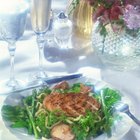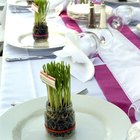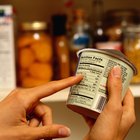
Setting up a healthy food timetable is an ideal way to get your kids eating right. Starting them off with a filling breakfast, packing a healthy lunch and making a good dinner will ensure that your kids have energy throughout the day and get the proper levels of vitamins and nutrients. A healthy after-school snack can also go a long way toward getting the recommended five daily servings of fruits and vegetables. Having scheduled meal times will get your kids used to eating three square meals a day, so have regular family meals at home and get kids involved in cooking.
Breakfast
The United States Department of Agriculture recommends that at least half of the grains consumed be of the whole-grain variety. With this in mind, serve whole-grain toast or cereal to your kids in the morning. Oatmeal and cornmeal are also whole grains, so these can be served hot with or without milk for breakfast. Give your child some of his daily portion of fruits by serving blueberries or raspberries, or cutting up bananas or strawberries and putting them in cereal.
Lunch
Use school lunch to give your child more fruits and veggies, and to get some of the protein he needs throughout the day. Make a peanut butter sandwich on whole-grain bread, as long as your child's school does not have allergy restrictions. A turkey sandwich with lean meat and lettuce can also help your child get protein throughout the day. Supply a granola bar, an apple or another piece of fruit for dessert.
Afterschool Snack
Children are often hungry when they get home from school. Satisfy their cravings with a low-calorie healthy snack that will not spoil their appetite for dinner. A piece of fruit is always satisfying, as is carrot or celery sticks with hummus or creamy salad dressing. Give your child protein with a handful of almonds or cashews mixed with raisins. Whole-grain pretzels also make a good snack, along with a dip.
Dinner
A regularly timed dinner helps you give your kids protein and vegetables. The USDA recommends fish and seafood dishes throughout the week. Prepare salmon, trout or tuna at least a couple of nights per week. Beef and poultry also provide the protein your kids need. Another dinner option is a vegetable casserole with cheese. Include broccoli, spinach, tomatoes, onions and other vegetables to give your child the five daily servings he needs.
Related Articles
Nutrition to Help Your Child Grow Taller

Menu for a Calorie-Restricted Diet

The Importance of Eating Lunch to a ...
What Breakfast Is Easy to Make for a ...

The Effects of Eating Breakfast on High ...

Menus for Toddlers & Five-Year-Olds for ...

High Fiber & Protein Diet Menus
Do All Fruit Snacks Have Gelatin in ...

Banquet Menu Ideas for Kids
Menu for a Low-Fiber Diet

What Is the Nutritional Value of an ...

What Should a Teen Girl Eat in a Day?

Kids' Snacks That Start With the Letter ...
Foods to Give a Toddler to Help With ...
Selenium For Children

Vitamin B6 Dosing for Children

Menu for Breakfast, Lunch & Dinner

How to Write a Poem for Your Child

Federal Government Grants for Child Day ...

Low Calorie High Energy Foods
References
Resources
Writer Bio
David Coodin began working as a writer in 2005, and has been published in "The Walrus." He contributes to various websites, writing primarily in the areas of education and art. Coodin holds a Ph.D. in English literature from York University in Toronto.
Photo Credits
Stockbyte/Stockbyte/Getty Images